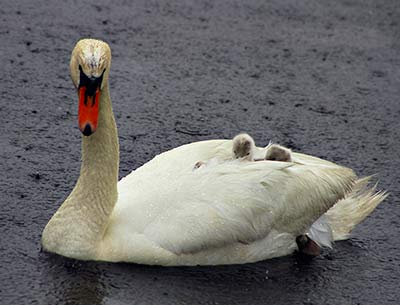A New State Plan for Mute Swans

State wildlife officials still have mute swans in their sights, but they’ve toned down their attack since their first proposal last year, which elicited protest from thousands.The New York State Department of Environmental Conservation released a revised management plan Monday for the non-native invasive species, which are said to be aggressive toward people and to displace native wildlife. The first draft, issued in January 2014, called for their elimination in New York State by 2025, and sparked outrage from animal activists and residents who have grown fond of the large, graceful birds.Changes to the proposal include a revised focus on minimizing swan impacts, rather than getting rid of all free-flying swans. Regional approaches would recognize the difference in impacts between upstate New York, where the D.E.C. said there were no mute swans before 1980, and other areas of the state. “This would generally limit mute swans to Long Island, New York City, and the lower four counties of the Hudson Valley (Orange, Rockland, Putnam and Westchester counties), with fewer than 800 birds in total and as few as possible occurring in tidal waters or other important wildlife habitats,” the D.E.C. said in its revised proposal. There are about 2,200 mute swans statewide. “A much smaller and managed population of this non-native species will best serve the public desire to see mute swans while protecting the integrity of wetland ecosystems in New York,” the D.E.C. said.The D.E.C. initially planned to shoot, capture and euthanize, or sterilize mute swans, and have their eggs and nests destroyed.However, the revision offers “a commitment to full consideration of non-lethal techniques, including egg-oiling and and placement of swans in possession of persons licensed by D.E.C., except where immediate removal of swans is necessary to protect health or safety.” The D.E.C. said this change would require “some commitment of funding and assistance from organizations and individuals who wish to see non-lethal options used to the extent possible.” Municipalities would be permitted to keep swans at local parks and other areas, which “can be costly to local governments or communities,” it said.Mute swans, brought to North America to beautify estates in the Hudson Valley and on Long Island in the late 1800s and escaped from captivity around 1910, compete with native wildlife for aquatic food plants and nesting areas, according to the D.E.C. The free-ranging population can be found in coastal bays, marshes, and wetlands, and on lakes, rivers, and ponds throughout New York. Several live on Town Pond and Hook Pond and at the Nature Trail in East Hampton Village.The first draft of the management plan also would have prohibited the feeding of mute swans. While the D.E.C. still discourages feeding of mute swans and other wild waterfowl, the revision would allow for feeding of mute swans in community-based management programs."Wildlife management can present challenges in trying to balance conflicting interests, such as when a beautiful bird has undesirable impacts,” D.E.C. commissioner Joe Martens said. “This revised plan remains committed to minimizing the impacts of mute swans on wildlife dependent on wetlands for their habitats, while being sensitive to public concerns about how and where that is accomplished.”The D.E.C. said it met with organizations such as the American Society for the Prevention of Cruelty to Animals, Ducks Unlimited, the New York State Fish and Wildlife Management Board, and the United States Department of Agriculture’s Wildlife Services. “As a result of this thoughtful public input, the plan is greatly improved,” Mr. Martens said.The D.E.C. is accepting comments on the revised management plan through April 24. Comments may be summated in writing to N.Y.S.D.E.C. Bureau of Wildlife, Swan Management Plan, 625 Broadway, Albany, N.Y. 12233, or by email to fwwildlf@gw. dec.state.ny.us.
